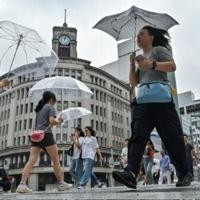A typhoon of significant strength hit Japan’s Pacific coast on Friday, leading to the cancellation of numerous flights and trains in the Tokyo region and causing power outages in over 4,000 homes.
Typhoon Ampil, positioned about 300 kilometers south of Tokyo, brought gusts reaching 216 kph as it moved northwards, as reported by the Japan Meteorological Agency.
The typhoon was not expected to make landfall, but was anticipated to travel northeast along the Honshu coast, bypassing the Tokyo area and heading back into the Pacific Ocean by Saturday.
The JMA classed the typhoon as “very strong”, just below the highest category of a “violent typhoon”, with maximum wind speeds reaching 195 km/h.
Warnings were issued by the agency for potential storms, high waves, landslides, and flooding through a social media announcement.
The US military’s Joint Typhoon Warning Center predicted sustained wind speeds of 110 knots and gusts of 135 knots near the coastal region of Chiba east of Tokyo by 3:00 pm.
As of Friday morning, over 4,000 households in Tokyo’s neighboring prefectures, particularly Chiba, were without power due to the typhoon, according to the utility provider.
Flight cancellations included 335 by All Nippon Air and 361 by Japan Airlines, impacting a combined total of around 129,000 passengers. Additionally, major bullet train services were suspended on Friday, including the route between Tokyo and Nagoya, and Tokyo Disneyland announced closure from 3:00 pm.
The typhoon coincided with Japan’s “obon” holiday week when many travel to their hometowns, following Tropical Storm Maria which caused heavy rainfall in parts of the north.
A study released recently indicated that typhoons in the region are forming closer to coastlines, increasing in intensity more quickly and persisting longer over land due to climate change.
Researchers analyzed historic and predicted storms from the 19th to 21st century, revealing these trends.
nf-cg/stu/cwl





